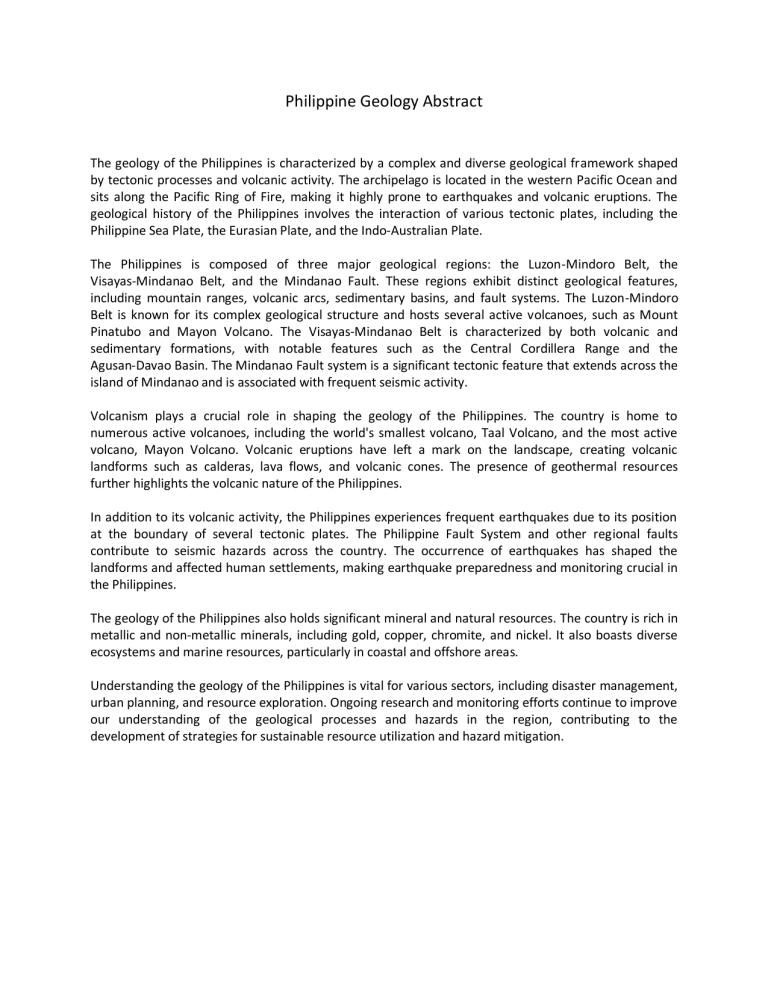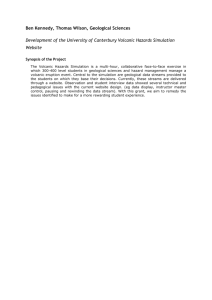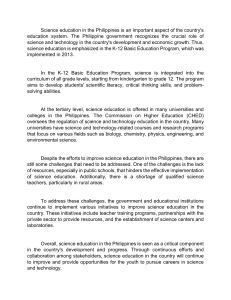
Philippine Geology Abstract The geology of the Philippines is characterized by a complex and diverse geological framework shaped by tectonic processes and volcanic activity. The archipelago is located in the western Pacific Ocean and sits along the Pacific Ring of Fire, making it highly prone to earthquakes and volcanic eruptions. The geological history of the Philippines involves the interaction of various tectonic plates, including the Philippine Sea Plate, the Eurasian Plate, and the Indo-Australian Plate. The Philippines is composed of three major geological regions: the Luzon-Mindoro Belt, the Visayas-Mindanao Belt, and the Mindanao Fault. These regions exhibit distinct geological features, including mountain ranges, volcanic arcs, sedimentary basins, and fault systems. The Luzon-Mindoro Belt is known for its complex geological structure and hosts several active volcanoes, such as Mount Pinatubo and Mayon Volcano. The Visayas-Mindanao Belt is characterized by both volcanic and sedimentary formations, with notable features such as the Central Cordillera Range and the Agusan-Davao Basin. The Mindanao Fault system is a significant tectonic feature that extends across the island of Mindanao and is associated with frequent seismic activity. Volcanism plays a crucial role in shaping the geology of the Philippines. The country is home to numerous active volcanoes, including the world's smallest volcano, Taal Volcano, and the most active volcano, Mayon Volcano. Volcanic eruptions have left a mark on the landscape, creating volcanic landforms such as calderas, lava flows, and volcanic cones. The presence of geothermal resources further highlights the volcanic nature of the Philippines. In addition to its volcanic activity, the Philippines experiences frequent earthquakes due to its position at the boundary of several tectonic plates. The Philippine Fault System and other regional faults contribute to seismic hazards across the country. The occurrence of earthquakes has shaped the landforms and affected human settlements, making earthquake preparedness and monitoring crucial in the Philippines. The geology of the Philippines also holds significant mineral and natural resources. The country is rich in metallic and non-metallic minerals, including gold, copper, chromite, and nickel. It also boasts diverse ecosystems and marine resources, particularly in coastal and offshore areas. Understanding the geology of the Philippines is vital for various sectors, including disaster management, urban planning, and resource exploration. Ongoing research and monitoring efforts continue to improve our understanding of the geological processes and hazards in the region, contributing to the development of strategies for sustainable resource utilization and hazard mitigation.







